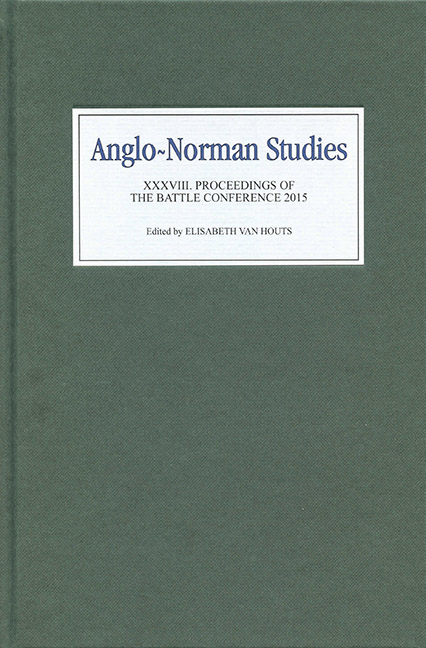Book contents
- Frontmatter
- Contents
- Illustrations and Tables
- Editor's Preface
- Abbreviations
- From the Articles of the Barons to Magna Carta (The R. Allen Brown Memorial Lecture, 2015)
- Jews in the Glosses of a Late Twelfth-Century Anglo-Norman Gratian Manuscript (Cambridge, Gonville and Caius College, MS 283/676)
- Monastic Autonomy, Episcopal Authority and the Norman Conquest: The Records of Barking Abbey (The Marjorie Chibnall Memorial Essay, 2015)
- Economy Distorted, Economy Restored: Order, Economy and Salvation in Anglo-Norman Monastic Writing
- Monastic Patronage and Family Disputes in Eleventh- and Early Twelfth-Century Normandy
- Constance, Princess of Antioch (1130–1164): Ancestry, Marriages and Family
- Early Aristocratic Seals: An Anglo-Norman Success Story
- English Towns and Urban Society after the Norman Conquest
- Wreck of the Sea in Law and Practice in Eleventh- and Twelfth-Century England
- Social Life and Religious Culture in Twelfth-Century Norwich and Norfolk
- Bad Crusaders? The Normans of Southern Italy and the Crusading Movement in the Twelfth Century
- Turold, Wadard and Vitalis: Why Are They on the Bayeux Tapestry?
Jews in the Glosses of a Late Twelfth-Century Anglo-Norman Gratian Manuscript (Cambridge, Gonville and Caius College, MS 283/676)
Published online by Cambridge University Press: 12 September 2017
- Frontmatter
- Contents
- Illustrations and Tables
- Editor's Preface
- Abbreviations
- From the Articles of the Barons to Magna Carta (The R. Allen Brown Memorial Lecture, 2015)
- Jews in the Glosses of a Late Twelfth-Century Anglo-Norman Gratian Manuscript (Cambridge, Gonville and Caius College, MS 283/676)
- Monastic Autonomy, Episcopal Authority and the Norman Conquest: The Records of Barking Abbey (The Marjorie Chibnall Memorial Essay, 2015)
- Economy Distorted, Economy Restored: Order, Economy and Salvation in Anglo-Norman Monastic Writing
- Monastic Patronage and Family Disputes in Eleventh- and Early Twelfth-Century Normandy
- Constance, Princess of Antioch (1130–1164): Ancestry, Marriages and Family
- Early Aristocratic Seals: An Anglo-Norman Success Story
- English Towns and Urban Society after the Norman Conquest
- Wreck of the Sea in Law and Practice in Eleventh- and Twelfth-Century England
- Social Life and Religious Culture in Twelfth-Century Norwich and Norfolk
- Bad Crusaders? The Normans of Southern Italy and the Crusading Movement in the Twelfth Century
- Turold, Wadard and Vitalis: Why Are They on the Bayeux Tapestry?
Summary
Thomas of Marlborough, abbot of Evesham (1229–1236), asserted that he had been taught canon law by three masters: Honorius, John of Tynemouth and Simon of Southwell. He himself had taught canon law in Oxford before becoming a monk at Evesham in 1199/1200. From the evidence adduced by Stephan Kuttner and Eleanor Rathbone it seems almost certain that he was taught canon law by the masters he named in Oxford as well. Honorius is likely to have taught there upon his return from Paris in 1192 until 1195, when he became one of the officials of the archbishop of York, Geoffrey Plantagenet. John of Tynemouth (d. c. 1221) would have left Oxford around 1198 when he was appointed by Hubert Walter to serve in his household as a legal expert. He ended his life as archdeacon of Oxford. Simon of Southwell entered Hubert's household around 1193. Unlike John he had taught in Bologna and Paris. Valuable evidence for the teaching of John of Tynemouth and Simon of Southwell comes from a unique manuscript in Gonville and Caius College, Cambridge, MS 283/676, which contains a late twelfth-century Anglo- Norman gloss on Gratian. Many individual glosses are ascribed to John of Tynemouth and Simon of Southwell. Based on the analysis of Kuttner and Rathbone it is possible to say that the gloss provides us with a snapshot of how Gratian's Decretum was taught in Oxford in the final decade of the twelfth century.
The research of Kuttner and Rathbone and of Charles Duggan identified many of the continental canonists cited in the A-NG. They include Huguccio (d. 1210), the author of an immensely popular Summa decretorum; John Faventinus (fl. 1170s and 1180s), whose very widely disseminated Summa on the Decretum overtook the Summae of Rufinus and Simon of Tournai upon which he had largely built his own composition; and Gandulphus (fl. 1160–70), who produced glosses on the Decretum and who might have taught Huguccio. My own research has confirmed the connection Kuttner made between the A-NG and the so-called Summa Lipsiensis, an Anglo-Norman product which is now thought to have been composed by Rodoicus Modicipassus in Paris around 1186. The Summa Lipsiensis used the work of John Faventinus; it in turn was used by Huguccio.
- Type
- Chapter
- Information
- Anglo-Norman Studies XXXVIIIProceedings of the Battle Conference 2015, pp. 19 - 34Publisher: Boydell & BrewerPrint publication year: 2016



